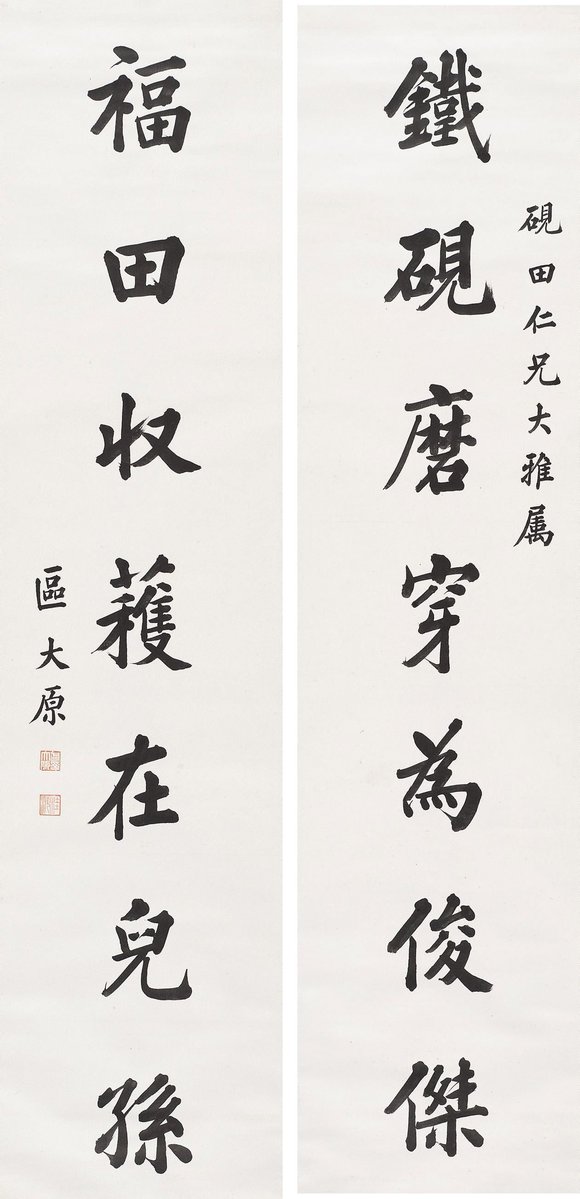

-
Details
- Place where the work was made
-
China
- Period
- Qing dynasty 1644 - 1911 → China
- Media categories
- Scroll , Calligraphy
- Materials used
- pair of hanging scrolls; ink on paper
- Dimensions
-
a - right scroll, 133 x 32 cm, image
a - right scroll, 169.5 x 38.5 cm, scroll
b - left scroll, 133 x 32 cm, image
b - left scroll, 169.5 x 38.5 cm, scroll
- Signature & date
Signed l.l. part b, in Chinese, inscribed in black ink "... Ou Dayuan".
Signed l.l. part b, in Chinese, stamped in red ink “Ou Dayuan yin [artist's seal]".
Signed l.l. part b, in Chinese, stamped in red ink “Guihai [artist's seal]".
Not dated.- Credit
- Gift of Dr. James Hayes 2003
- Location
- Not on display
- Accession number
- 284.2003.a-b
- Copyright
- Artist information
-
Ou Dayuan
Works in the collection
- Share
-
-
About
‘By using up an inkstone one can become a person of outstanding accomplishment;
To plough the fields guarantees a harvest for your descendants.’
Insciption and signature: [Written] at the request of Yantian, Ou Dayuan.The charm and allusion of this couplet depends upon word play and puns which are partly phonetic, partly allusive. It obliquely hints at the recipient’s name (Yantian) by highlighting the two images of ‘yan’ (inkstone) and ‘tian’ (rice field). The poetic expression and meaning are cunningly composed around these two characters. ‘Using up an inkstone’ alludes to the years traditional Chinese scholars spend studying the ancient classics and philosophical treatises in the hope of passing the civil service examination. Passing this examination allowed them to enter government service, the key to a life of privilege that would benefit their descendants.
The couplet would be encouraging for an enterprising scholar, while also mirroring the author’s own experience. Ou Dayuan grew up in an ordinary family in a village called Songtang in Nanhai, Guangdong. In 1903, along with his cousin Ou Dadian, he qualified in the metropolitan examination and was granted the ‘jinshi’ degree. His career as a bachelor at the Hanlin Academy did not last long. The two cousins fled to Hong Kong when the Qing dynasty fell. Ou Dayuan spent the rest of his life there, supporting himself mainly by selling his calligraphy.
The couplet was composed in ‘kaishu’ (regular script). During the Qing period, ‘kaishu’ was a must for all novices of calligraphy and a stepping stone to official success. The system of civil service examinations not only placed a premium on the good command of calligraphy, but also developed a writing style, known as ‘guan’geti’ (script of cabinet), derived from regular script, but stiffer, almost like printed text. Its required features were that it be black, square, smooth and even. All candidates of the examination consciously adopted this style of calligraphy. This couplet reflects such a style.
‘The Poetic Mandarin: Chinese Calligraphy from the James Hayes Collection’. pg.122.
© 2005 Art Gallery of New South WalesThe couplet, written on two narrow pieces of paper or silk, and hung either side of a large painting or doorway, is one of the most common forms of calligraphic art and has a long standing history in China. They first appeared in the Five Dynasties period (907-979) as pairs of plaques, carved after written master copies, to decorate architectural columns, courtyards and garden doorways. Couplets for indoor display, written on paper or silk, came into existence in the 17th century and gained great popularity in the Qing dynasty. The couplets themselves are either taken from classical poetry or contemporary literary works composed by the calligraphers themselves and their friends. A couplet is made up of two parts called the head and the tail. The two lines of verse are antithetically parallel. Formerly it was a very common practice to send them to friends or relations on such occasions as marriages and birthdays, or as condolences to families of deceased persons.
Asian Art Department, AGNSW, August 2003.
-
Places
Where the work was made
China
-
Exhibition history
Shown in 1 exhibition
The poetic mandarin: Chinese calligraphy from the James Hayes collection, Art Gallery of New South Wales, Sydney, 23 Sep 2005–27 Nov 2005
-
Bibliography
Referenced in 1 publication
-
LIU Yang, The poetic mandarin: Chinese calligraphy from the James Hayes collection, Sydney, 2005, 122, 123 (illus.). cat.no. 38
-
